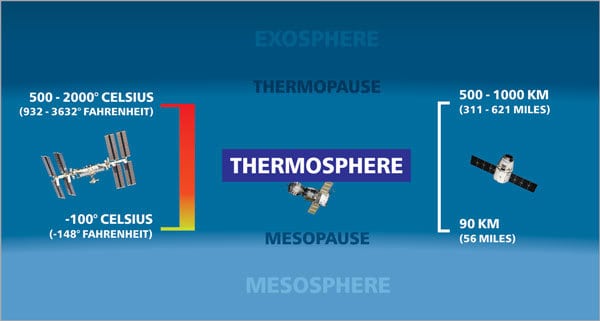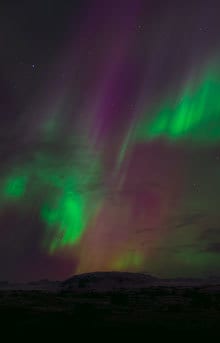The Thermosphere: Defining The Characteristics Of Earth’s Fourth Atmospheric Layer

It may be one of the outermost layers of the Earth's atmosphere, but the importance of the thermosphere cannot be underestimated. We take a closer look at this atmospheric layer and its characteristics.
The thermosphere is the fourth of Earth's five atmospheric layers, situated above the mesosphere and below the exosphere at an altitude of 90 km or 56 miles and extends to 1000 km or 621 miles. It is the hottest atmospheric layer and the part of the atmosphere where the Aurora Borealis occur.
Situated close to the boundary between the atmosphere and space, the thermosphere is only separated from outer space by the exosphere, Earth's fifth and outermost layer.
Although Earth's fourth atmospheric layer has very few characteristics in common with the three layers closer to the planet's surface, it still has a valuable role to play.
We examine not only what the defining characteristics of the thermosphere are but also the facts that separate it from the other four layers of the atmosphere.
Thermosphere Definition

The thermosphere is the last atmospheric layer which characteristics carry any resemblance to the rest of the atmosphere as we know it. Above its upper boundary, the exosphere blends seamlessly into the vacuum of space.
It was already briefly described during the introduction, but in order to examine the thermosphere in more detail, a more comprehensive definition is required.
What Is The Thermosphere?

The thermosphere is the fourth layer of the atmosphere, situated above the mesosphere and below the exosphere at an altitude of 90 km (56 miles) to 1000 km (621 miles).
The meteorological phenomenon, the Aurora Borealis (Northern Lights), occurs in this layer at heights of 150 km (93 miles) and above.
It is also considered the atmosphere's hottest layer, with temperatures reaching 2000° Celsius (3632° Fahrenheit).
The thermosphere is situated just above the mesosphere, with a thin layer of air called the mesopause separating the two layers. It reaches up to the exosphere, with another thin layer of air called the thermopause separating them.
The name of the thermosphere is derived from the Greek word, θερμός (thermos), meaning heat. (Referring to the high temperatures reached in the layer.)
At 513 km (319 miles), it is the thickest of the atmosphere's four inner layers and thicker than the troposphere, stratosphere, and mesosphere combined. (But not as thick as the exosphere that stretches for thousands of miles into space.)

By some definitions, space starts at 100 km (62 miles) above Earth, so it is not surprising that the thermosphere is seen as part of outer space in many circles. The air is extremely thin at this altitude, where the Earth's gravitational pull is also greatly reduced.
Due to these characteristics, this is a highly utilized part of the atmosphere where over 800 active satellites orbit the planet, and it is also home to the International Space Station (ISS).
(Not to mention the large number of space debris also orbiting in the thermosphere.)
One of the most well-known characteristics of the thermosphere is the presence of the Aurora Borealis (Northern Lights), the spectacular meteorological phenomenon that occurs over regions in the Arctic Circle.

The Aurora Borealis is a result of charged particles from the sun colliding with gaseous particles in the thermosphere. This causes the colorful light display observers in the Northern Hemisphere are so familiar with. (Green is one of the common colors created.)
Another unique feature of the thermosphere is the extremely high temperatures that occur within this layer. With temperatures reaching up to 2 500° Celsius (4 530° Fahrenheit), the thermosphere is the hottest of all the atmosphere's layers by a huge margin.
The temperature is not constant, though. Between day and night, an average difference of 200° Celsius (360° Fahrenheit) can occur. The amount of solar radiation also has a direct influence on the temperature, causing as much as a 500° Celsius (900° Fahrenheit) variation.
You will also not be able to feel the extremely high temperatures this layer experiences. The air is so thin that it basically resembles a vacuum, with no particles/atoms in the air to conduct the heat.
The stratosphere is well-known for containing the important ozone layer, which is essential for protecting life on Earth from the Sun's deadly UV radiation. The thermosphere, though, also plays a role in protecting the planet from solar radiation.
It absorbs a large amount of incoming Ultraviolet and X-ray radiation, which emphasizes the importance of this layer. The incoming solar rays interact with gas molecules during the absorption process, which contributes to the high temperatures reached within this layer.
A large portion of the Ionosphere also falls within the thermosphere since ions are created when Ultraviolet Radiation causes the photoionization of molecules.
Facts About The Thermosphere
The following list highlights the characteristics and facts of the thermosphere in more detail.
- 1The thermosphere is the fourth layer of the atmosphere (above the troposphere, stratosphere, and mesosphere.)
- 2It extends from a height of approximately 90 km (56 miles) to 1000 km (621 miles) above the Earth's surface.
- 3It borders the mesosphere below through a thin transitional space called the mesopause.
- 4It borders the exosphere above through a thin transitional space called the thermopause.
- 5It is the part of the atmosphere where low-orbiting satellites and the International Space Station are found.
- 6The thermosphere is the hottest of the five atmospheric layers, with temperatures reaching up to 2 500° Celsius (4 530° Fahrenheit).
- 7It is home to the meteorological phenomenon, the Aurora Borealis (also known as the Northern Lights).
- 8A large part of the Ionosphere is located in the thermosphere.
- 9Like the stratosphere, the thermosphere plays an important part in protecting the planet from the Sun's dangerous UV and X-ray radiation through absorption.
- 10It is the thickest of the four inner atmospheric layers at 513 km (319 miles).
- 11The layer is characterized by the presence of atmospheric waves (similar to those experienced in our oceans.)
- 12It makes long-distance radio communication possible by allowing radio waves to bounce off the ions in the layer allowing it to travel over longer distances.
Although this list does not contain all the data available about the thermosphere, it highlights the key facts and characteristics of this layer.
Conclusion
Like the three atmospheric layers below it, the thermosphere has a vital role to play in protecting the planet and all life in it, as this article illustrated.
Although it only has a fraction of the gas and other particles present in lower layers, the thermosphere is situated at the ideal height for low-obit space utilization and contains enough gas molecules to absorb a significant amount of dangerous solar radiation.
If you are interested in the complete structure and make-up of the atmosphere, this article covers all five atmospheric layers and their relation to each other in more detail.
Never miss out again when another interesting and helpful article is released and stay updated, while also receiving helpful tips & information by simply following this link .
Until next time, keep your eye on the weather!
